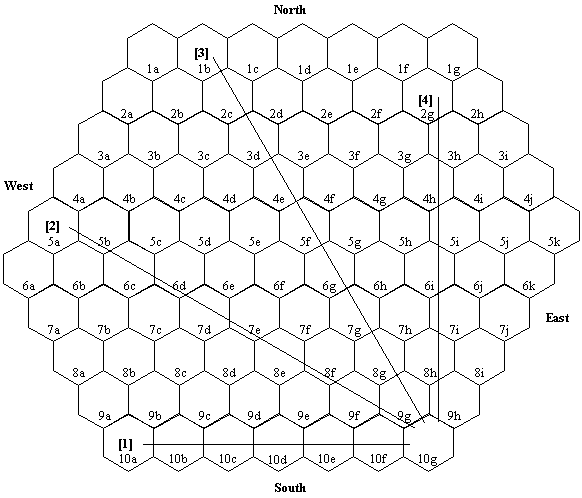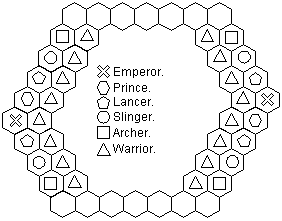Mi ARENA CHEX.
A chess variant game designed by Brent Thomas.

Straight rows of cells.
[1] File. There are ten, West to East, with any two cells connected by a shared side.
The North and South files are called the forest files. These have seven cells.
Adjacent to a forest file there is an Archers file with eight cells. Adjacent to an Archers file there is a Slingers file with nine cells. Adjacent to a Slinger's file there is a Lancer's file with ten cells. Between the Lancers files are the central Emperors and the Princes files. These have eleven cells.
[2] Alley. Two, three, four, five or six unconnected cells at an angle to any file.
[4] Rank. Two, three, four or five, North to South, unconnected cells.
Objective of the game.
The two players have the objective of creating a situation that is known as "Chex".
This is the eminent capture of the most important piece, the Emperor. The player with the threatened Emperor must immediately remove the threat of "Chex" by:
- Moving the Emperor to a safe position.
- Moving another piece to a position where he blocks the threat.
- Capturing the piece that is making the threat.
- A player wins the game when his opponent cannot, or will not, remove the eminent capture of his Emperor.
This situation is known as "Chexmate".
Drawn games.
These occur when;
- The situation that is known as a "stalemate" occurs when, in his turn a player cannot make a legal move and his Emperor is not in a "Chex" situation.
- Both players accept that no "Chexmate" is possible.
The Pieces.

The Moves.
Emperor. An Emperors usual move is one unoccupied cell, in any direction on a file, an alley, a diagonal or a rank.
Traverse. He moves two unoccupied cells on one of his end diagonals, toward an Archer. Then that Archer is moved onto the cell that the Emperor moved across.
Please note! A Traverse with the Princes Archer will transfer this Archer onto the files that the Emperors Archer plays on.
Rule No. 1. " An Emperor is not permitted to move onto a cell where he would be captured".
Rule No. 2. " An Emperor is not permitted to traverse to avoid being captured".
Rule No. 3. " An Emperor is not permitted to make a traverse when he or the Archer have already moved".
Rule No. 4. " An Emperor is not permitted to make a capture by means of a traverse".
Prince. A Prince can move in any direction, any number of unoccupied cells on a file, an alley, a diagonal or a rank.
Lancer. A Lancer can move in any direction, any number of unoccupied cells on a diagonal.
Slinger. A Slinger 'jumps', in any direction, within a group of six cells that are either two joined files or diagonals. The jump is to an unoccupied cell at the opposite end of the adjacent three cell row.
Archer. An Archer can move in any direction, any number of unoccupied cells on a file or a rank.
Warrior. A Warriors usual move is one unoccupied cell, on his file, toward the opposite end. His other moves are: first move can be one or two moves on unoccupied cells on his own file.
Rule No. 5. "When a Warriors progress is blocked by any other Warrior, he is permitted to move one unoccupied cell that is diagonally adjacent and forward of him".
Rule No. 6. "A promotion to an Archer, a Slinger, a Lancer or a Prince can be given to a Warrior who has moved onto, or makes a capture on, an opposite end cell. A promotion to any piece is only permitted if that piece has been previously captured and removed from the game".
Making a capture. Any enemy piece, except the Emperor, that can be reached, can be captured and removed from the game. Each piece usually makes a capture the same way as he moves. A Warrior only makes a capture on a cell that is diagonally adjacent and forward of him.
Notations.
In all commentaries, all notations must be placed between the cells IDs.Move notation Symbol. Example. What it describes.
- 2a - 10a The piece on cell 2a moves to cell 10a.
x 2a x 10a The piece on cell 2a captures the piece on cell 10a.
T T - 4a The White Emperor Traverses to cell 4a.
(-) (x) This move or capture puts the Emperor in chex.
((-)) ((x)) This move or capture puts the Emperor in double chex.
:-: :x: This move or capture creates an uncovered chex.
In some commentaries, the following notations may be used.
! Good move. !! Very good move. ? Unclear motive. ?? Blunder.
See Thomas' Word-document for this description with printable board and score-sheet, which can be downloaded for personal use.
© Copyright 1999 Brent Thomas.
3/7 Andamooka Place
Alexandra Hills QLD 4161
AUSTRALIA.
Any comments?
Mail me at: brucenjo@dcc.net.au.
P.S. Please reply by mail to my home address. Any advice from you will be gratefully appreciated.
Written by Brent Thomas.
WWW page created: July 7, 1999. Last modified: December 7, 2000.